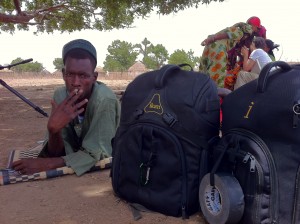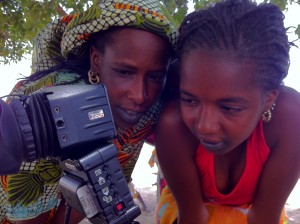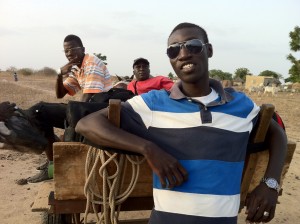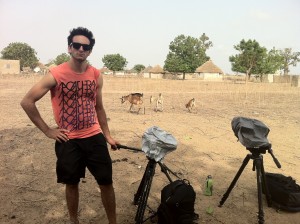Shooting in Senegal (Part 1): Talent Comes First
By Chris Collins:
I came up in a film school where the DP was God. We would basically spend hours on one lighting setup for a 3 second shot. It’s a great way to learn what works and what doesn’t work with regards to lighting and frame, but I missed the most important aspect of camera department… you are the rock!
Here in Mbour, Senegal we are working with local non-actors. When my B unit camera operator, Luke Hanlein, and I met the locals for the first time it was quite apparent that our job would be a challenge. Breaking out even a flip cam was sure to attract a crowd, and our actors are used to chilling alone with cows all day long. Herein lies the problem. Our talent is unfamiliar with the concept of marks, they hate going up for a second take of anything, they’re unaccustomed to working even an 8 hour day, and a huge crowd gathers every time we set up a camera. Add this to the fact that Luke and I can’t understand a word of what anybody else is saying. It seems like a recipe for disaster, but we are the professionals so it is our job to find a solution.
Some of our scenes take place in the villages and some take place in the city of Mbour. Our cast is all from the village, and we’ve found that they are extremely uncomfortable being filmed in the city. What we have done to make them more comfortable is shoot from as far away as possible. This means throwing the Canon 70-200 on a 1.6x crop camera and putting lavs on talent. Fortunately this adheres to our plan to compress the city scenes and shoot the village scenes on wider lenses to portray the vastness of the land. We did not plan on shooting at the 200mm range of the lens, but we make little sacrifices to make talent more comfortable.
For the village scenes we have the luxury of shooting closer to talent, but we try to stay out of their eyelines as much as possible, and we get TONS of broll and cutaways to use when they spike the camera. We have found that their body language tells the story just as well, if not better, than their dialogue. This is tricky with only two cameras and few chances for second and third takes, so I try to grab this footage before we start to roll. Granted, this is our first few days of shooting. It takes some time to get everybody on the same page with regards to what needs to happen in order to make a great film. It’s a bit like walking on eggshells, but I’d rather befriend our subjects before asking them to do anything that may jeopardize their comfort. It also wins me points with director, Jeremy Teicher. Ultimately, it’s a balancing act between what looks best for camera and what works best for performance.
The most important part of making talent feel comfortable hasn’t had to do with camera at all. I actually spend more time dancing and poking fun of myself for being a toubab (whitey) than I do behind the camera. I’ve picked up on the local customs (mostly napping and complaining which is easy for me), and I do my best to fit in. I eat things I’d rather not eat and touch things I’d rather not touch, but it’s for the good of the film. I suppose the most important part of shooting in Africa is respecting the people that you are working with, and joining their culture to the best of your ability. I have to say that I’m having a hell of a time doing so!
Check out the project web site here…
Click here to see Part 2 of this article.
















Pingback: This Is Us: A Film in Africa (Stage 1) « Wide Open Camera